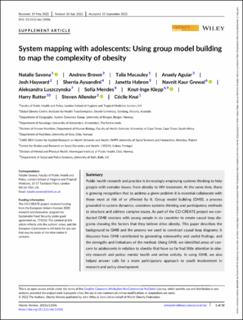| dc.contributor.author | Savona, Natalie | |
| dc.contributor.author | Brown, Andrew | |
| dc.contributor.author | Macauley, Talia | |
| dc.contributor.author | Aguiar Rodriguez, Anaely | |
| dc.contributor.author | Hayward, Josh | |
| dc.contributor.author | Ayuandini, Sherria | |
| dc.contributor.author | Habron, Janetta | |
| dc.contributor.author | Grewal, Navnit Kaur | |
| dc.contributor.author | Luszczynska, Aleksandra | |
| dc.contributor.author | Mendes, Sofia | |
| dc.contributor.author | Klepp, Knut Inge | |
| dc.contributor.author | Rutter, Harry | |
| dc.contributor.author | Allender, Steven | |
| dc.contributor.author | Knai, Cécile | |
| dc.date.accessioned | 2023-02-14T12:46:42Z | |
| dc.date.available | 2023-02-14T12:46:42Z | |
| dc.date.created | 2022-12-01T13:50:13Z | |
| dc.date.issued | 2022 | |
| dc.identifier.issn | 1467-7881 | |
| dc.identifier.uri | https://hdl.handle.net/11250/3050724 | |
| dc.description.abstract | Public health research and practice is increasingly employing systems thinking to help grapple with complex issues, from obesity to HIV treatment. At the same time, there is growing recognition that to address a given problem it is essential collaborate with those most at risk of or affected by it. Group model building (GMB), a process grounded in system dynamics, combines systems thinking and participatory methods to structure and address complex issues. As part of the CO-CREATE project we conducted GMB sessions with young people in six countries to create causal loop diagrams showing the factors that they believe drive obesity. This paper describes the background to GMB and the process we used to construct causal loop diagrams; it discusses how GMB contributed to generating noteworthy and useful findings, and the strengths and limitations of the method. Using GMB, we identified areas of concern to adolescents in relation to obesity that have so far had little attention in obesity research and policy: mental health and online activity. In using GMB, we also helped answer calls for a more participatory approach to youth involvement in research and policy development. | en_US |
| dc.language.iso | eng | en_US |
| dc.publisher | Wiley | en_US |
| dc.rights | Attribution-NonCommercial-NoDerivatives 4.0 Internasjonal | * |
| dc.rights.uri | http://creativecommons.org/licenses/by-nc-nd/4.0/deed.no | * |
| dc.title | System mapping with adolescents: Using group model building to map the complexity of obesity | en_US |
| dc.type | Journal article | en_US |
| dc.type | Peer reviewed | en_US |
| dc.description.version | publishedVersion | en_US |
| dc.rights.holder | Copyright 2022 The Author(s) | en_US |
| cristin.ispublished | true | |
| cristin.fulltext | original | |
| cristin.qualitycode | 1 | |
| dc.identifier.doi | 10.1111/obr.13506 | |
| dc.identifier.cristin | 2087120 | |
| dc.source.journal | Obesity Reviews | en_US |
| dc.identifier.citation | Obesity Reviews. 2022. | en_US |

